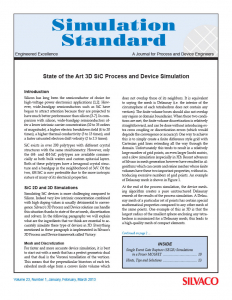State of the Art 3D SiC Process and Device Simulation
Introduction
Silicon has long been the semiconductor of choice for high-voltage power electronics applications [1,2]. However, wide-bandgap semiconductors such as SiC have begun to attract attention because they are projected to have much better performance than silicon [3-7]. In comparison with silicon, wide-bandgap semiconductors offer a lower intrinsic carrier concentration (10 to 35 orders of magnitude), a higher electric breakdown field (4 to 20 times), a higher thermal conductivity (3 to 13 times), and a faster saturated electron drift velocity (2 to 2.5 times).
SiC exists in over 200 polytypes with different crystal structures with the same stoichiometry. However, only the 6H- and 4H-SiC polytypes are available commercially as both bulk wafers and custom epitaxial layers. Both of these polytypes have a hexagonal crystal structure and a bandgap in the neighborhood of 3eV. Of the two, 4H-SiC is now preferable due to the more isotropic nature of many of its electrical properties.



